Hawk Identification score cards:
The score cards below show the correct features for Hawks to the best of this authors information. However, when looking at Hawks for sale today, you may very well see features from several different years mixed on the same car. This is because a lot of the parts will fit Hawks they were not intended for. One of the best examples is to find the 1957 through 1963 deck lid on a 1956 Hawk. A 1956 Hawk hood will fit on 1957 to 1959 Silver Hawks or the 1960 or 1961 Hawk. Two-tone paint also get a lot of non-authentic application, both in color choices and location.
A lot of the information was taken from Fred Fox's October 1992 Turning Wheels article "Studebaker Hawks: a primer".
|
Hawk Tail Fin Tells |
|
|
1956 Golden Hawk rear fin. This is the only 1956 Hawk to have a small fiberglass fins. Because it was a hardtop, a tell for 1956 is the "Check Mark" side trim. |
|
|
1956 Sky Hawk rear fender. No fins, chrome trim on the top of the fender. Because it's a hardtop, the "Check Mark" side trim.
|
|
|
1956 Hawk coupes (Power Hawk) & (Flight Hawk). No fins, chrome trim on top of the fender, no "Check Mark". Narrow two-tone paint trim molding after the rear window and before the deck lid. |
|
|
1957 & 58 Golden Hawk, five chevrons. The top and bottom trim comes to a point in line with the door handle. No Hawk badges. |
|
|
1957 & 58 Silver Hawk, no chevrons, the bottom trim is straight and lined up below the door handle. The top trim curves down to the straight trim. |
|
|
1959 would be the only year with "Silver" & "Hawk" script and a black background Hawk badge. The front trim no longer comes to a point. |
|
|
1960 only "Hawk" script with a red background Hawk badge near the rear of the fin and three chevrons near the front. Same front trim with no point. |
|
|
1961 the "Hawk" script moves to the front and the red background hawk badge moves to the rear. A new center trim molding creates a narrow color band. |
|
Hawk Grille & Signal Lights Tells |
|
|
All 1956 Hawks would have the same hood, hood ornament, signal lights and grille badge. The side grilles would be plain with out ornamentation as would the 1957 Silver Hawk. However, only 1956 Hawks would have the fender mounted lights back from the headlight rings around four inches. |
|
|
The three moldings in the side grilles identify 1957 Golden Hawks (the only year they are seen). The fiberglass overlay with a simple gold "V" badge is present on all 57 & 59 Golden Hawks, needed to clear the supercharger. The fender mounted lights are mounted closer to the headlight rings. |
|
|
The 1957 Silver Hawk would have plain side grilles like all 1956 Hawks and use the same hood ornament as 1956, however the bulge behind the ornament would now taper all the way to the cowl edge of the hood. Also 1957 Hawks would have the fender mounted signal lights closer to the headlight rings then they are on this car. The accent color (white) should be inside the outer grilles not the base color as shown here. |
|
|
1958 Golden Hawk shown. The fender signal lights were close to the headlight rings as they should be. They also have grown fins (the only year those fins would be seen.) Side grilles now have mesh. A new round hawk badge is seen on the grille, unique to only 1958 Hawks. |
|
|
1959 Silver Hawk shown. The hood ornament and the bulge behind it look exactly like the former 1957 & 1958 Silver Hawks and the future 1960 & 1961 Hawks. The mesh inside the side grilles is the same as 1958 Hawks. However the signal lights have moved off the fenders and inside the side grilles. The large round hawk grille badge is gone in favor of a smaller round badge with a black background. |
|
|
1960 Silver Hawk shown. The only difference between the 1959 Silver Hawk shown above and 1960 & 1961 Hawks is that the background color in the grille badge is red instead of black. This very minor change makes 1959 to 1961 Hawks hard to identify from the front. |
|
These badges were seen on the front grilles, some rear decks (1956 to 1958), some rear fins (1959 to 1961) |
|
|
|
|
|
|
1956 & 1957 Hawk Badges |
1958 Hawk Grille Badge |
1959 Hawk Badge |
1060 & 1961 Hawk Badges |
|
|
|
|
The decklid for 1956 are unique because of the combination lock and badge molding in the center required a flat spot in the grooves which would not be present on later Hawks. All four Hawks for 1956 have name script on the left side of the molding and "Hawk" script on the right in chrome. |
|
|
In 1957 through 1961 the lock would be in the same place and small and simple and the flat spot from 1956 removed. The badge & script is moved to the lower right side. Golden Hawk script would be gold and Silver Hawk script would be chrome. This pattern would carry on for 1958 as well. |
|
|
1959, 1960, and 1961 decklids are all alike. The prior rear badging would move to the rear fins. Bold block "Studebaker" lettering in chrome would be centered just below the lock. Like the front, this makes these years hard to identify from the rear. |
1956
to 1961 Studebaker Hawks
1955 President Speedster:
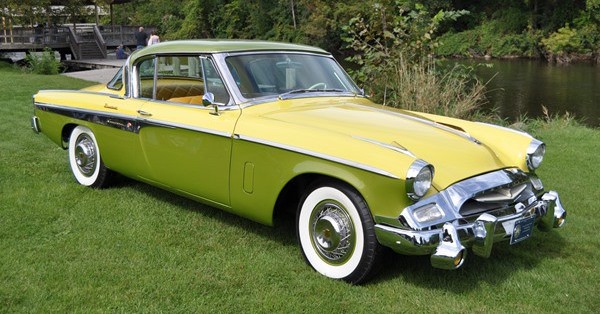 The
predecessor to the 1956 Hawks is a special 1955 President hardtop
called the Speedster. The first President Speedster was completed on
August 27 th, 1954. It was quickly followed by another 13
units over the next week or so. These 14 Speedsters were intended
for display purposes only, but as they quickly became big hits,
Studebaker decided to test the market and put the Speedster into
production at about mid-year. Even though it was the most expensive
model offered for 1955 at $3,253, around $800.00 more then a
President hardtop, it sold well. When 1955 production ended, 2,215
domestic Speedsters had been assembled. South Bend manufactured
1,795 and Los Angeles (Vernon plant) assembled 420. Another 81 were
built for export in South Bend.
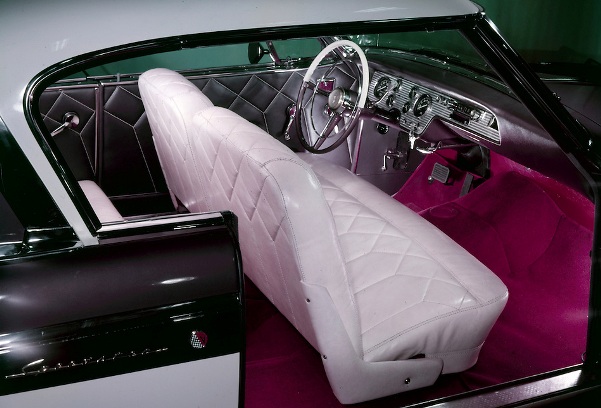 Speedsters
are distinguished by their stainless-steel roof band,
"shoemaker-stitched" diamond-quilted genuine top-grain
leather upholstery, an engine-turned instrument panel, a 8,000 rpm
tachometer, a 160 mph speedometer, an electric clock, tinted glass,
carpeting front and rear, and Six two-tone and three three-tone paint
schemes. It had a map pocket, but no glove box.
The
buyer had a choice of either Automatic Drive or standard transmission
with overdrive. Other standard equipment included power steering,
power brakes, four-barrel carburetor, oil filter, oil bath air
cleaner, turn signals, two speed electric windshield wipers, duel
exhaust, duel back-up lights, triple horns, tubeless whitewall tires,
fog-light bumperettes, hood-length hood ornament (gold plated),
special Speedster badges, chrome plated ashtrays, chrome plated
rear-view-mirror moldings, (six) two-tone and (three) three-tone
paint schemes, tailpipe extensions, and simulated wire wheel covers.
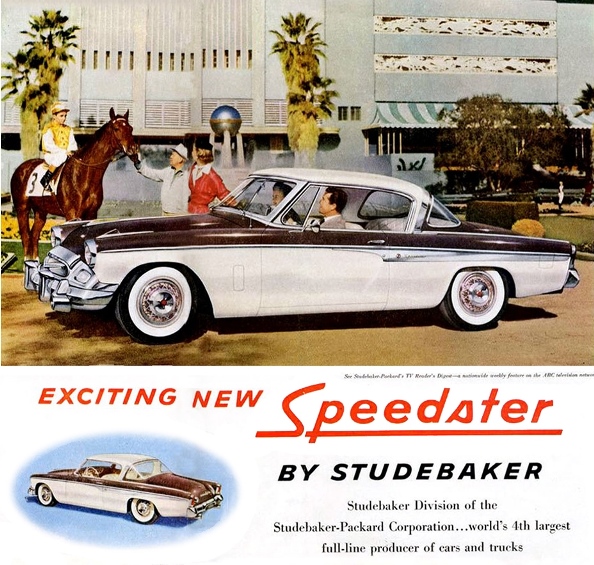 While
the Speedster is often praised as the reason for the Hawks, the
actual 1956 Hawk design had been on paper for some time before the
1955 Speedster was ever created. However what the Speedster did do
is confirm for Studebaker that the Hawks were going to be a winner. Studebaker's target with their “Family Sports Car” was pointed
directly at the Chevy Corvette and Ford Thunderbird, but in this
authors opinion the target they hit was the first “Muscle Car” /
“Personal Luxury Car”, which would become even more apparent with
the release of the Gran Turismo.
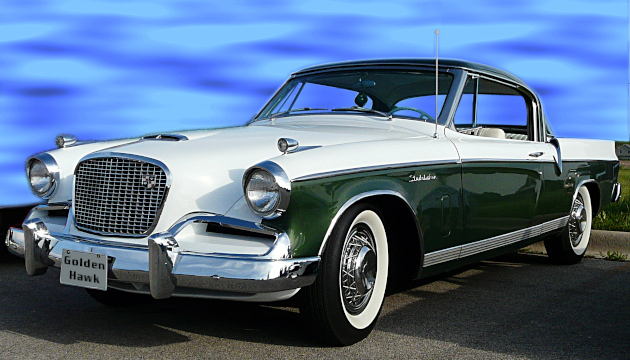 The
development of the Hawk line was done by Robert Bourke, Raymond
Lowey's South Bend styling chief. With little design money to work
with the existing C&K body gets a new hood, rear deck with a new
rear panel with horizontal grooves, a new die cast somewhat square
mesh grille, and a new engine-turned instrument panel facing. The
Hawk would feature round Stewart-Warner gauges. There would be four
models this first year, the Golden Hawk & Sky Hawk (K-body)
hardtops and the Power Hawk & Flight Hawk (C-body) 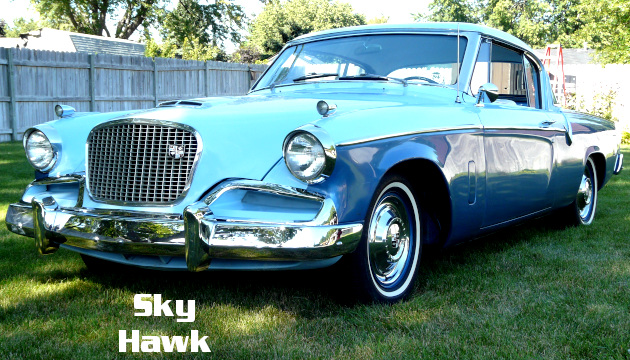 coupes. The
Golden Hawk would feature a 352 cubic inch Packard V-8, the Sky Hawk
Studebaker's 289 cubic inch V-8, the Power Hawk Studebaker's 259
cubic inch V-8 and the Flight Hawk Studebaker's 185 cubic inch
flat-head six. However, there were actually nine Flight Hawks built
using the K-body hardtop. Another 52 Flight Hawk hardtops were built
in Canada and 499 (56G-K7) hardtops were exported from South Bend. The Golden Hawk would be the only 1956 Hawk to be fitted with that
small vertical fiberglass rear fender fin. Also, 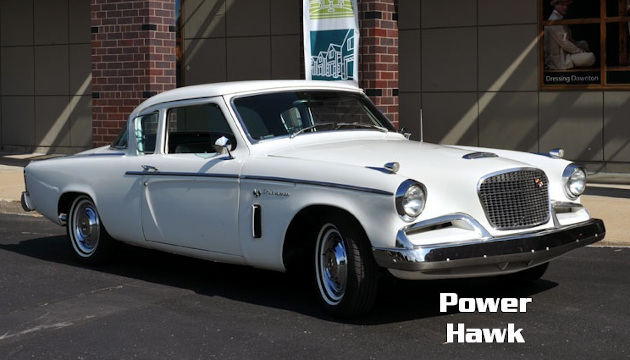 unique to only the
Golden Hawks would be that grooved bright metal molding just above
the rocker panels and the wide stainless-steel trim just above the
rear window.
Tells
for 1956 Hawks: The hood is unique to 1956 as it is the only
year that 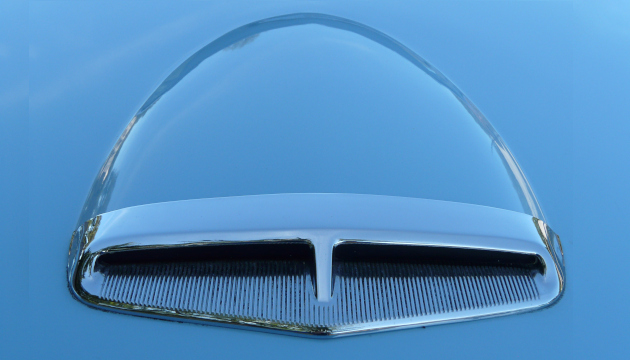 the scoop ends just behind the Hood Ornament. The rear
deck is also unique because of the combination lock and badge
arrangement (lock in the lower edge 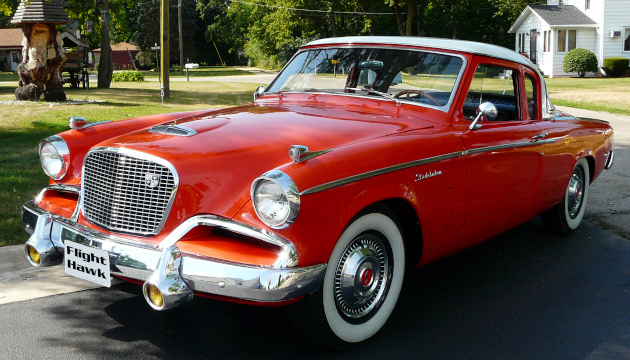 of the badge). There is also a
flat spot where the grooves are discontinued to create the mounting
surface for that badge and lock. Also, the model name badges and
their location on the rear deck lid are unique to 1956. The front
fender mounted turn signals are mounted about four inches farther
back on the fender then they would be in 1957 & 1958. The side
grille openings are plain with no mesh, parking lights, or moldings. Only the 1957 Silver Hawk side grilles would look like the 1956 side
grilles.
|
Model |
Model Code |
Engine |
Displacement in
cubic inches |
HP |
HP w/4bbl |
Starting Engine
Serial Numbers |
|
Flight Hawk |
56G-C3 |
185 Six |
185.6 |
101 |
─── |
SB─1,180251
CA─C-66,001
LA─L-3,201 |
|
Power Hawk |
56B-C3 |
259 V8 |
259.2 |
170 |
185 |
SB─V-363,751
CA─VC-8,101
LA─VL-6,301 |
|
Sky Hawk |
56H-K7 |
289 V8 |
289 |
─── |
210 |
SB─P22,001
CA─PC-601
LA─PL-2,701 |
|
Golden Hawk |
56J-K7 |
1352
V8 |
352 |
─── |
275 |
w/OD─K-1,001
w/A─S-1,001
OD=overdrive
A=automatic |
SB─=South
Bend, CA─=Canada, LA─=Los Angeles. These prefixes define
production locations and are not part of the engine serial number.
The 1956 Hawk wheel color was the same as the body color (lower
color on two-tones). 1956 Flight, Power, and Sky Hawk engine
blocks were painted turquoise. The V8's had black valve covers. 1The
1956 Golden Hawk has a Packard 352 engine with the block painted
red and the valve covers painted silver.For
detailed engine information see the following links to that
information on this website. V8
or Packard-V8
or 185 Six. |
|
1956 Hawk
Production |
|
Flight Hawk (6 cyl.) |
South Bend |
Los Angeles |
Canada |
Export |
Total |
|
Coupe (56G-C3) C-body |
2,509 |
557 |
584 |
740 |
4,380 |
|
Hardtop (56G-K7) K-body |
9 |
0 |
52 |
499 |
560 |
|
Power Hawk (258 V8) |
South Bend |
Los Angeles |
Canada |
Export |
Total |
|
Coupe (56B-C3) C-body |
4,815 |
1,360 |
507 |
413 |
7,095 |
|
Sky Hawk (289 V8) |
South Bend |
Los Angeles |
Canada |
Export |
Total |
|
Hardtop (56H-K7) K-body |
2,103 |
570 |
71 |
306 |
3,050 |
|
Golden Hawk (352 V8) |
South Bend |
Los Angeles |
Canada |
Export |
Total |
|
Hardtop (56J-K7) K-body |
3,178 |
601 |
51 |
241 |
4,071 |
|
Grand Total |
12,613 |
3,088 |
1,265 |
2,199 |
19,165 |
|
1956 Hawk Serial
Numbers and List Price |
|
Model |
South Bend |
Canada |
Los Angeles |
Price |
|
Flight Hawk 56G-C3 |
G-1,357,501 |
G-763,701 |
G-936,701 |
$1,986.00 |
|
Power Hawk 56B-C3 |
8,429,601 |
8,960,001 |
8,849,101 |
$3,095.00 |
|
Sky Hawk 56H-K7 |
7,171,001 |
7,900,601 |
7,808,501 |
$3,215.00 |
|
Golden Hawk 56J-K7 |
6,030,001 |
─── |
6,800,001 |
$3,360.00 |
|
The numbers
above are starting serial numbers. Except for the Golden Hawks
these numbers are mixed in with 1956 Sedan and Wagon production
usually by engine type, thus the first serial number listed above
may not have even been a Hawk. |
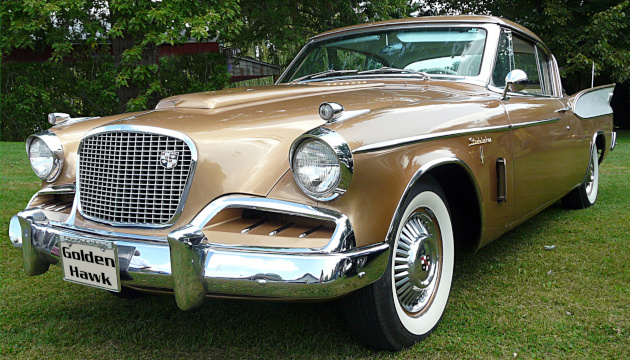 For
1957 the number of models is reduced to from to (2). The Golden
Hawk is retained, the only hardtop (K-body), a new name appears
for the coupe (C-body) the Silver Hawk. 1956 Golden Hawk Packard
engine is history, to maintain the 275 horsepower it provided, the
1957 Golden Hawk uses the 289 Studebaker V8 with a McCulloch
supercharger. This combination required that a
triangular hole be be cut into the hood to make room for the
supercharger. This hole was covered with a fiberglass overlay which
started near the front of the hood and continued till the hood meets
the cowl. A small gold V badge is placed on the front of the
overlay. 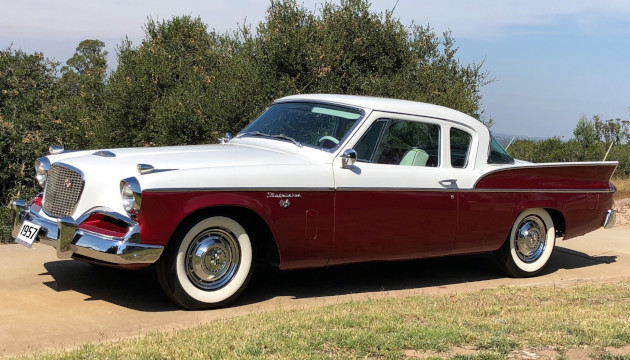 The Silver hawk's hood is also modified, but while it did
not require a hole (no supercharger) it used the hood ornament from
1956, but the hood bulge behind the air scoop would continue very
close to the end of the hood near the cowl. The grooved lower
molding seen on the 1956 Golden Hawk would not appear on the 1957
Golden Hawk. The Golden Hawk stainless-steel wheel trim is retained,
but the Silver Hawk would be void of this trim. The chrome moldings
below the windshield and doors seen on 1953 to 1955 K bodies would be
returned for the Golden Hawk, but not appear on the Silver Hawk. However, the scallop indentation in the doors ,which started in 1953,
would disappear for both the 1957 Hawks. Both Hawks would sport the
new outwardly canted metal rear fender fins styled by Ducan McRea. However, the Golden Hawk would also have five vertical chevrons near
the back of the fin. New round tail lights and back-up lights would
be found in a painted tail light housing. In late spring of 1957
Studebaker would release a limited edition Golden Hawk 400. Initially 10 show cars were built and later another 41 regular
production units were built. These cars featured true leather
upholstery in tan or white and a fully lined Burtex covered truck
compartment. Something else that is unique is the accent color of
the rear fins was also made present inside the side grilles in the
front of the car. The tan leather would be carried over to the 1958
Packard Hawk. The first 10 show cars were identical, painted Tiara
Gold with Arctic White fins and side grilles. As of a few years ago,
supposedly two of these have survived. The production units were of
a wider variety of colors and two-tones, supposedly eight are known
to have survived. A few (maybe as few as three) clones have been
created. The status of the survivors and clone information I found
was from posts on the SDC Forum dated 2005.
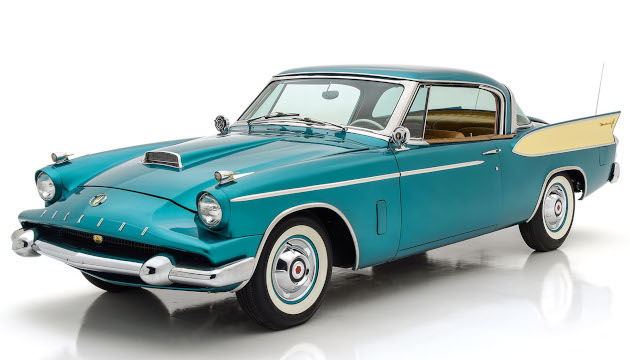 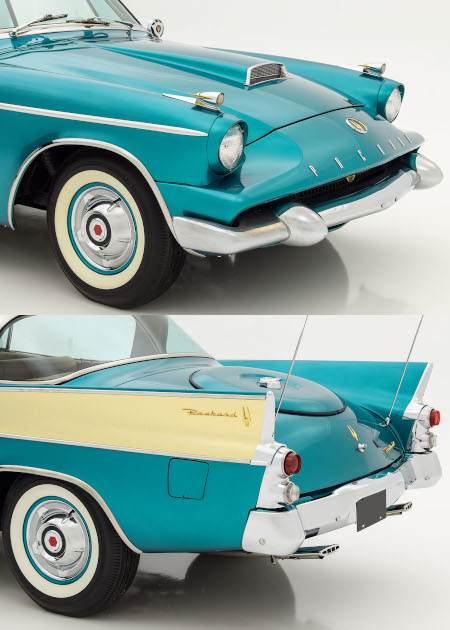 In
1958 the same line-up continued with few changes. However, the 1958
Packard Hawk (one year model only) was released (58L-K9). It would
have nearly the same leather upholstery as the 1957 Golden Hawk 400's
(apparently the color and texture were slightly different). The
Packard Hawk featured a 53-55 rear deck, sloping fiberglass hood 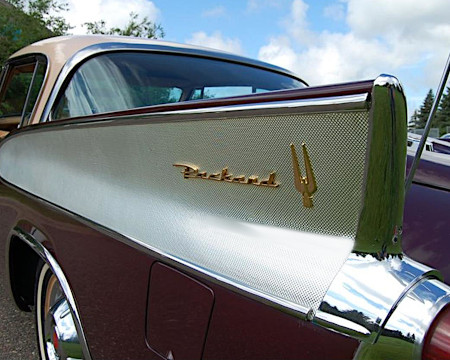 and
a wide narrow fiberglass grille enclosure. Gold anodized mylar
overlays graced the rear fins and a imitation spare tire cover was
placed on top of the deck lid. This would be the only Hawk to ever
have painted headlight rims. Another unique feature was the vinyl
tan pads that run along the outside of the windows. Mechanically the
Packard Hawk is identical to the supercharged 1958 Golden Hawk. All 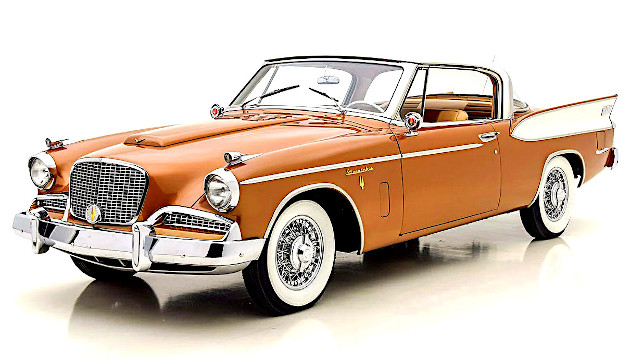 1958 Hawks (except optional on Silver Hawk six) sported 14 inch rims
and tires, so new hubcaps were featured. 1958 would be the last year 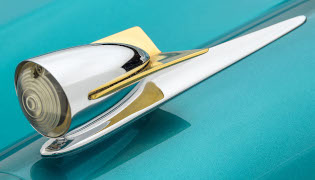 for front fender mounted turn signal lights and the only year they
sported rear fins. These fins were gold on the Packard Hawk and
Chrome on Golden and Silver Hawks. This is also the first year in
the Hawk series where a single piece driveshaft is employed. 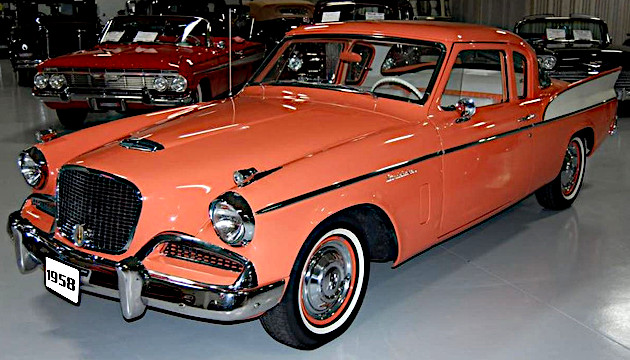 Factory
air conditioning is first offered including supercharged Golden Hawks
& Packard Hawks. The door sill plates are narrower on the 1958
Hawks and are now stainless-steel instead of aluminum.
Tells
for 1957 Hawks:
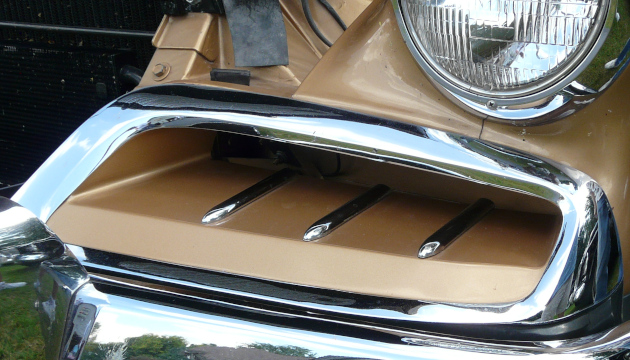 The
three moldings on the bottom of the side grilles on 1957 Golden Hawks (right photo) is unique to this year. For 1957 Silver 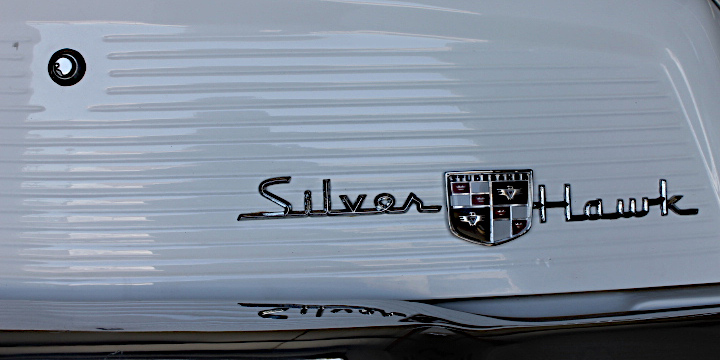 Hawks, it is not so much
what you see as what you don't see. You will see plainly adorned
side grilles (no mesh like 1958 and similar to 1956). No fins on the
back of the front fender signal lights (exactly like 1956) but placed
much closer to the front of the fender. The Silver Hawk badge (left photo) on lower
right of deck lid is exactly like 1958 but a lot different then 1956
when there was no Silver Hawk.
Tells
for 1958 Hawks:
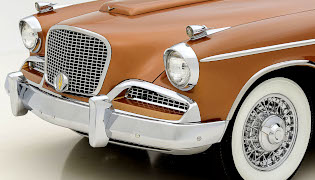 Both
Golden (Golden Hawk shown left photo) and Silver Hawks can be easily identified in the front by rear
fins on the back of the fender mounted front signal lights. Mesh in
the side grilles with no signal lights. The very large round Hawk
badge in the lower part of the front main grille. This badge is the
most significant tell for 1958 Hawks as it is the only year it would
be seen. Packard Hawks need no tells, they were actually a
one-of-a-kind model.
1957 & 1958
Silver & Golden Hawk Two-tone Paint Schemes
|
Model |
Area with accent
color |
|
Year |
1957 |
1958 |
| Silver Hawk |
Silver
Hawk
top
half |
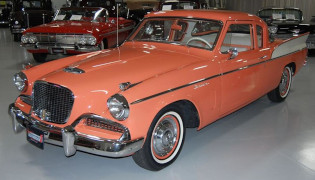 Silver Hawk
fin only |
| Golden Hawk |
Golden
Hawk
fin only |
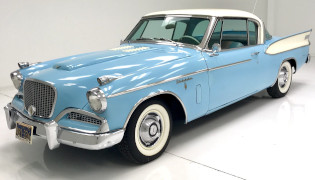 Golden Golden
Hawk
top & fin |
|
1957 Hawk
Production |
|
|
|
|
|
1957 Silver Hawk |
South Bend |
Canada |
Export |
Total |
|
Coupe (57G-C3) C-body Six |
2,997 |
489 |
677 |
4,163 |
|
1Hardtop
(57G-K3) K-body Six |
0 |
0 |
120 |
120 |
|
1Coupe
(57B-C3) C-body 259 V8 |
0 |
812 |
368 |
1,180 |
|
1Coupe
(57B-K3) K-body 259 V8 |
0 |
152 |
96 |
248 |
|
Coupe
(57H-C3) C-body 289 V8 |
9,461 |
2 |
144 |
9,607 |
|
1957 Silver Hawk Totals |
12,458 |
1,455 |
1,405 |
15,318 |
|
1957 Golden Hawk |
South Bend |
Canada |
Export |
Total |
|
Hardtop (57H-K7) K-body |
4,131 |
42 |
183 |
24,356 |
|
Grand Total |
16,589 |
1,497 |
1,588 |
19,674 |
|
1These
models were only sold outside the US. 210 show
units and 41 production units were built as special “400”
model Golden Hawks. |
|
1958 Hawk
Production |
|
|
|
|
|
1958 Silver Hawk |
South Bend |
Canada |
Export |
Total |
|
Coupe (58G-C3) C-body Six |
1,782 |
239 |
421 |
2,442 |
|
1Coupe
(58B-C3) C-body 259 V8 |
0 |
0 |
0 |
0 |
|
1Coupe
(58B-K3) K-body 259 V8 |
0 |
295 |
72 |
367 |
|
Coupe
(58H-C3) C-body 289 V8 |
4241 |
56 |
0 |
56 |
|
1958 Silver Hawk Total |
6,023 |
590 |
737 |
7,350 |
|
1958 Golden Hawk |
South Bend |
Canada |
Export |
Total |
|
Hardtop (58H-K7) K-body |
756 |
0 |
122 |
878 |
|
1958 Packard Hawk |
South Bend |
Canada |
Export |
Total |
|
Hardtop (58L-K9) K-body |
546 |
0 |
42 |
588 |
|
Grand Total |
7,325 |
590 |
901 |
8,816 |
|
1These
models were only sold outside the US. |
|
1957 Hawk Serial
Numbers and List Price |
|
Model |
South Bend |
Canada |
Price |
|
Silver Hawk 57G-C3 Six |
G-1,379,201 |
G-769,101 |
$2,142.00 |
|
1Silver Hawk
57B-C3 259 V8 |
8,454,101 |
8,962,601 |
─── |
|
Silver Hawk 57H-K7 289 V8 |
7,171,001 |
7,900,601 |
$2,263.00 |
|
Golden Hawk 57H-K7 |
6,100,001 |
─── |
$3,182.00 |
|
The numbers
above are starting serial numbers. Except for the Golden Hawks
these numbers are mixed in with 1957 Sedan and Wagon production
usually by engine type, thus the first serial number listed above
may not have even been a Hawk. 1These
models were only sold outside the US. |
|
1958 Hawk Serial
Numbers and List Price |
|
Model |
South Bend |
Canada |
Price |
|
Silver Hawk 58G-C3 Six |
G-1,405,401 |
G-772,301 |
$2,219.00 |
|
1Silver Hawk
58B-C3 259 V8 |
8,471,601 |
8,965,101 |
─── |
|
Silver Hawk 56H-K7 289 V8 |
7,210,001 |
7,902,001 |
$2,352.00 |
|
Golden Hawk 58H-K7 |
6,104,501 |
─── |
$3,282.00 |
|
Packard Hawk 58L-K9 |
58LS-1,001 |
─── |
$3,995.00 |
|
The numbers
above are starting serial numbers. Except for the Golden Hawks
these numbers are mixed in with 1957 Sedan and Wagon production
usually by engine type, thus the first serial number listed above
may not have even been a Hawk. 1These
models were only sold outside the US.1These
models were only sold outside the US. |
1959 Silver Hawk, 1960 & 1961 Hawk:
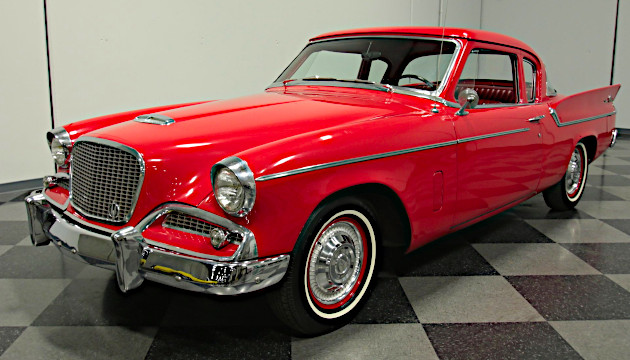 In 1959 the Golden Hawk, Silver Hawk
and Packard Hawk hardtops are retired. Also gone was the 185 Six and
289 V8's for Hawks. The only remaining Hawk was the Silver Hawk
coupe, only offered in 170 Six or 259 V8. The thinking for the
engine changes is to keep Hawk production inline with the new Lark
engine offering, making the Hawk more profitable. The V8 version has
stainless-steel wheel opening moldings, chrome taillight housings,
and stainless-steel roof drip moldings which were not seen on the
Six. However chrome moldings were added below the windshield and
side windows on both models. Two-tone paint would not be offered on
any 1959 Hawks, even though it is commonly seen today. Reclining
front seats were made optional in 1959. The fins trim is modified
from the 1957 & 1958 Hawks and would be similar on 1960 & 1961 Hawks. 15
inch wheels return as the standard after a one year use of 14 inch
wheels in 1958. Note that the car shown is a 259 V8, but it lacks the chrome wheel opening trim and the chrome drip rail trim. These items, if missing in a restoration are hard to find today and most likely accounts for the reason they are missing.
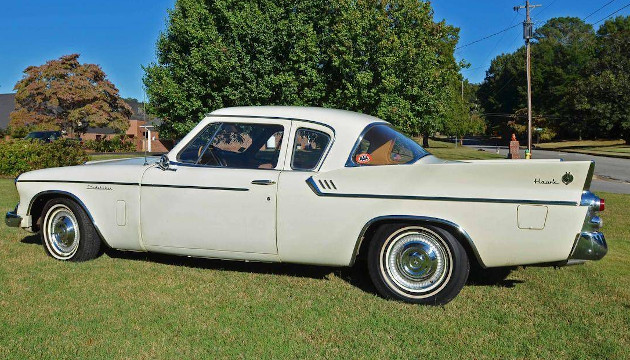 In 1960 Studebaker again offered only one model in
the Hawk line, the same coupe offered in 1959, but Studebaker would
drop the use of “Silver” and call the 1960 & 1961 just a
“Hawk”. For 1960 the 289 cubic inch V8 returned as standard
power, the 259 V8 and 170 six would still be offered outside the U.S. Stitching is added to the padded dash and carpet is added to the
lower panel of the interior door panels. Split front seats are first
offered as an option. Early 1960 V8's still had the four nut valve
covers, but shortly after production started for the 1960 model year,
the valve covers changed to the two nut version which would be seen
until the end in 1963.
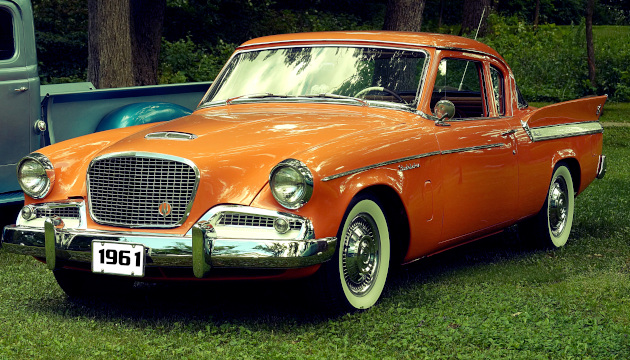
The 1961 Hawk coupe is nearly the same as
1960. Some minor trim changes on the rear fins are made, but the big
news for 1961 would be the availability of a four speed manual
transmission, Semi-bucket seats and the color band on the rear fins. The export 170 six would use the new overhead valve engine, however
no domestic Hawks would be built using this engine.
Tells for 1959 Silver Hawks:
 The fender mounted front signal lights
are gone and are replanted in the side grille  openings (photo left) . The large
center round badge found on the center grille of the 1958, is
replaced with a simpler round black background Hawk badge on the
lower right of the same center grille. 1959 Silver Hawk is the only
Hawks to sport “Silver Hawk” badges on the rear fins. They are
moved there from their prior location on the read deck lid. (photo right)
Tells for 1960 Silver Hawks:
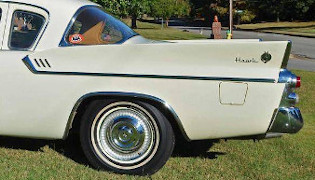 The background on that black badge is
now red. The rear fins show three chevrons near the door and “Hawk”
script with the red background hawk badge near the rear portion of
the fin.
Tells for 1961 Silver Hawks:
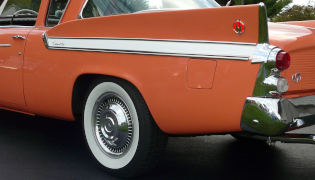 The rear fins have an additional chrome
trim through the center of the fin, creating a color band. The
“Hawk” script replaces the 1960 chevrons near the door and the
hawk badges move to the back of the fin, pretty much just reversed
from last year. The horn ring is replaced with a horn bar.
|
1959, 1960, &
1961 Hawk Production |
|
1959 Silver Hawk |
South Bend |
Canada |
Export |
Total |
|
Coupe (59S-C6) C-body Six |
1,942 |
223 |
252 |
2,417 |
|
Coupe
(57V-C6) C-body 259 V8 |
4,707 |
369 |
295 |
5,371 |
|
Grand Total |
6,649 |
592 |
547 |
7,788 |
|
1960 Hawk |
South Bend |
Canada |
Export |
Total |
|
Coupe (60S-C6) C-body Six |
0 |
0 |
227 |
227 |
|
1Coupe
(60V-C6) C-body V8 |
3,117 |
220 |
341 |
4,280 |
|
Grand Total |
3,117 |
220 |
568 |
4,507 |
|
1960 Hawk |
South Bend |
Canada |
Export |
Total |
|
2Coupe
(61S-C6) C-body Six |
0 |
0 |
266 |
266 |
|
Coupe
(61V-C6) C-body 289 V8 |
3,719 |
223 |
323 |
3,663 |
|
Grand Total |
3,719 |
223 |
589 |
3,929 |
|
1All
domestic 1960 & 1961 Hawks were built with 289 cubic inch
V8's. Some models sold outside the US were built with 259 cubic
inch V8's. |
|
1959, 1960 &
1961 Hawk Serial Numbers and List Price |
|
Model |
South Bend |
Canada |
Price |
|
Hawk 59S-C6 Six |
59S-1,001 |
59SC-1,001 |
$2,360.00 |
|
Hawk 59V-C6 V8 |
59V-1,001 |
59VC-1,001 |
$2,495.00 |
|
1Hawk 60S-C6
Six |
60S-1,001 |
60SC-1,001 |
─── |
|
Hawk 60V-C6 V8 |
60V-1,001 |
60VC-1,001 |
$2,650.00 |
|
1Hawk 61S-C6
Six |
61S-1,001 |
61SC-1,001 |
─── |
|
Hawk 61V-C6 V8 |
61V-1,001 |
61VC-1,001 |
$2,650.00 |
|
Starting in 1959
Studebaker added the model year as a prefix to the serial number
and therefore all the serial numbers could start each new model
year with 1,001. This numbering system had been seen on the 1957
& 1958 Packard. 1Only
sold outside North America. |
|